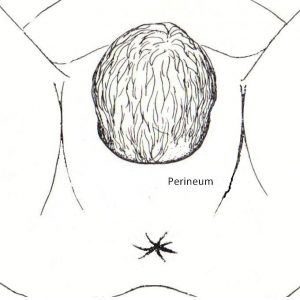 Last night a patient had an intact perineum after a spontaneous vaginal delivery. It was her first baby. There was some minor vaginal tearing only. I said to her she can expect to have a much better recovery because her perineum was intact.
Last night a patient had an intact perineum after a spontaneous vaginal delivery. It was her first baby. There was some minor vaginal tearing only. I said to her she can expect to have a much better recovery because her perineum was intact.
I often get asked by patients: “How can I avoid stitches?” The topic of perineal tearing is covered in the Question and Answer section of my web site in the article titled ‘Perineal Tearing at Delivery’.
Factors that are important.
There are various factors that are important in determining the likelihood of avoiding stitches with a vaginal delivery. These include…
- The elasticity of your tissues.
- The size of your baby, especially of your baby’s head. The larger the more likely you will have trauma.
- Whether your baby’s head is well flexed (tilting forward) or deflexed at delivery. A deflexed head means a bigger presenting diameter to deliver. This is common with an occipito–posterior (looking -up) position.
- Position of your baby’s head at delivery (whether occipito–anterior or occipito-posterior at delivery. Occipito-anterior (looking down) is better.
- Whether or not you have significant perineal scar tissue from a previous vaginal delivery. Scar tissue does not stretch as well.
- If there has been prolonged pushing. Then there is a greater likelihood of oedema (fluid) in the tissues. This reduces the tissue strength.
- The speed and control of the delivery of your baby’s head.
- Whether you have an epidural. An epidural is associated with less trauma as it usually a more controlled slower delivery of the baby’s head. It takes away that incredible and sometimes uncontrollable urge to push even when told not to. On the other hand, some women find it much harder to push their baby out with an epidural and end up with an operative vaginal delivery as a consequence.
- Your position at delivery. Delivering on “all fours” or on your side will mean there is less pressure on your perineum.
- Whether or not you push your baby out. If you have an operative vaginal delivery, then whether you have a vacuum cup delivery or a forceps delivery. There is less trauma, and often no trauma, with a vacuum cup delivery. This is because the suction cap is attached to the top of your baby’s head and as a consequence does not increase the stretch of your vaginal entrance. Also, there is more control of the delivery of the head possible with a vacuum cup allowing a slower and more controlled stretch of the vaginal entrance. Forceps are applied to the sides of the head of the baby and so by using forceps, there is a greater diameter coming through the vaginal entrance and so greater stretching. Because of this greater stretching forceps use means an episiotomy should be done to minimise tissue trauma. If an episiotomy is not done with forceps delivery, there is likely to be considerable tearing. Because I want no trauma for mum I prefer to use the vacuum cup rather than forceps if an operative vaginal delivery is needed.
- The competence, experience and attitude of your accoucheur. The accoucheur is the person delivering your baby.
There is a technique of delivery that I adopt that will increase the likelihood of you having an intact perineum. It involves teamwork with the mum when the widest diameter of the head is starting to stretch the vaginal entrance. I ask her to make a little push, then stop, then another little push, and so on and to continue this until the head is out. I am controlling the delivery of the head by cupping the baby’s head with the palm of my hand, so it comes out of the vaginal entrance very slowly and as deflexed as possible. With my fingers, I am also trying to gradually spread the stretch of the whole of the vaginal entrance so that the stretch is not concentrated on the perineum.
What can I do antenatally to avoid perineal trauma?
Not much
- Perineal massage is probably no use. There is no evidence I can find to prove it helps minimise the risk of perineal trauma.
- The EPI-NO logically should help avoid perineal tears and also the likelihood of an operative vaginal delivery. I am personally not convinced and as far as I can tell the scientific evidence is lacking. But using an EPI-NO won’t do harm.

